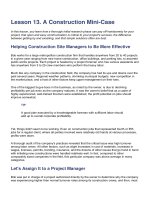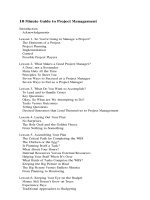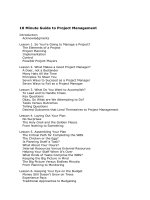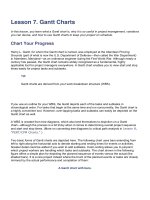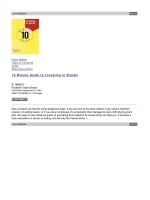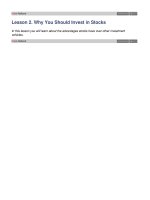10 Minute Guide to Investing in Stocks Chapter 7 ppsx
Bạn đang xem bản rút gọn của tài liệu. Xem và tải ngay bản đầy đủ của tài liệu tại đây (383.09 KB, 13 trang )
I l@ve RuBoard
Lesson 7. The Markets
In this lesson you will learn about the physical locations where stock is available for trade and
also about computerized networks over which stock is available for trade.
I l@ve RuBoard
I l@ve RuBoard
Trading Places
So, where are all these trades taking place? Way before there was money, people used to
trade items to each other. If I had a goat and you wanted it, you'd offer me three chickens in
trade, and we'd both go off happy. If someone else offered me four chickens, or if someone
else showed up with a bigger goat, there would probably be a lot of yelling involved.
Eventually, people finally figured out that they'd save time looking for other people with whom
to trade if they regularly showed up at one designated location where everyone brought
something to trade.
With the introduction of money, these trades evolved into purchases and sales. Thousands
of years later, the market concept is still very much alive. People who want to buy or sell
stocks figure that showing up at the same location at the same time to trade stocks is a pretty
good idea. Today, over 140 physical exchanges buy and sell trillions of shares of hundreds of
thousands of stocks 24 hours per day. Although those figures are mind-boggling, they
represent only a small fraction of the trades being conducted over computerized networks.
Here are the markets:
New York Stock Exchange (NYSE).
The largest physical stock exchange in the world.
American Stock Exchange (AMEX).
The rival of the NYSE in size and prestige.
Regional exchanges.
Fourteen exchanges located around the United States.
Over the counter.
A term for stocks traded over a computerized network called the National Market
System (NMS).
International exchanges.
Stock exchanges in other countries.
Other markets.
Markets where the trading of financial instruments other than stocks, such as futures,
options, and money, is conducted.
I l@ve RuBoard
I l@ve RuBoard
The New York Stock Exchange
Back in 1792, 24 men showed up to trade stocks under a buttonwood tree and pronounced
that location as their future stock-trading marketplace. The road next to the buttonwood tree
had been named for a blockade wall built earlier to keep Manhattan settlers safe from
marauding Indians and pirates. I'm not making this up. That market and its humble
beginnings eventually evolved into today's mammoth New York Stock Exchange, and the
corresponding road next to the blockade wall became known as Wall Street, synonymous
with today's financial world.
Plain English
The markets is a term referring to the centralized physical locations and the
computer networks at which the business of trading stocks is conducted.
The New York Stock Exchange (NYSE) is, hands down, the world's most famous and
powerful exchange as well as the largest stock exchange in the world. The ramifications of a
day's trades at this exchange are worldwide and affect commerce and governments alike.
For all its bedlam though, the NYSE trades only about 1,600 of the country's biggest stocks.
"Biggest" meaning no company with less than $18 million in assets or less than 1.1 million
issued shares need apply for a listing. Although the stock you purchase may be listed on the
exchange, this is definitely not the arena for individual investors. It is, however, a super-cool
place to visit if you are ever in New York. The exchange offers tours that prove the movies
are neither lying nor exaggerating when they portray the exchange as a bedlam of screaming
and waving.
I l@ve RuBoard
I l@ve RuBoard
The American Stock Exchange
The American Stock Exchange (AMEX) is also based in New York and has a great tale of
origin. In 1842 men who were not considered "gentlemanly enough" to be admitted into the
New York Stock Exchange stood outside the building, trading stocks on the curb and yelling
and hollering loud enough to ensure that they were being heard by the "gentlemen" inside.
These rabble-rousers, known as the New York Curb Exchange, traded stocks in this manner
until 1921 when they finally moved indoors. Subsequently, in 1953 this exchange changed its
name to The American Stock Exchange.
Plain English
The American Stock Exchange is the New York Stock Exchange's rival trading 900
of the nation's largest stock to the NYSE's 1,600. In addition, the AMEX requires the
issuing company to maintain a balance of $4 million in assets to the NYSE's
minimum requirement of $18 million.
AMEX's beginnings as a rogue market make for a good story, but the truth today is
somewhat less wayward. To this day, AMEX is still NYSE's closest competitor both in size
and in scope, trading about 900 of the country's biggest stocks. To be listed on the AMEX, a
company must maintain a minimum of $4 million dollars in assets and have issued a
minimum of a half million shares of stock. For the same reasons as at the NYSE, few if any
individuals conduct their trading business here.
I l@ve RuBoard
I l@ve RuBoard
Regional Exchanges
The two principal markets in the United States, the NYSE and AMEX, can actively trade only
a minuscule proportion of the total number of shares in the United States. For that reason, 14
other smaller exchanges, which are scattered around the country, are linked to the NYSE
and the AMEX in order to help them trade stock more quickly and effectively. These
exchanges, known as regional ex-changes, operate the same as the two big exchanges, and
often even duplicate their work.
Some of the better-known regional exchanges are …
Pacific Stock Exchange
Boston Stock Exchange
Midwest Stock Exchange
Philadelphia Stock Exchange
These exchanges, while perhaps not quite as well known as NYSE and AMEX, are significant
in their own right for many reasons. The Philadelphia Stock Exchange, for example, has the
distinction of being this country's first stock exchange. Its founding in 1790 predates the
founding of the NYSE by more than a quarter of a century, and the founding of AMEX by
over half a century.
Again, many of these exchanges trade the same stocks as their bigger counterparts to help
reduce the load that the major exchanges are expected to service. At the end of the day, the
results of trading a particular stock are added up from all locations and reported to the
general public as composite trading.
Think of the situation as a burger joint. The entire country couldn't walk into the same burger
joint and expect to be served within a reasonable time frame. So, the burger joint opens up
locations all over the country, and they all offer the same food to their customers. In the same
way, the regional exchanges offer the same stocks for trade to local investors as the big ones
do. At the end of the day, however, management wants to know how many burgers were sold
at all locations. After adding together the sales at all locations, the resulting total number of
burgers sold is known as the burger joint's composite trading figure.
Small Fry Regional Exchanges
Regional exchanges conduct their own proprietary business as well business for their bigger
counterparts. The requirements for a company to have its stock listed on the two major
exchanges are often prohibitive for many smaller companies. However, these companies can
usually meet the requirements of the smaller exchanges and for that reason are traded there.
For example, in the same burger joint scenario let's say you are a lobster fisherman. You
know that the national burger joint has no interest in your new product, the Lobster Burger. In
Maine, however, the Lobster Burger is a big hit. Rather than attempting to sell your Lobster
Burger to Burger Joint headquarters for distribution in all its locations, you take your Lobster
Burger idea directly to Burger Joint headquarters for the State of Maine. They agree to
distribute, or sell, your Lobster Burger exclusively through Maine. In the same way, a regional
exchange offers access to markets where many smaller companies can remain competitive.
I l@ve RuBoard
I l@ve RuBoard
Over the Counter
The least prestigious and most obscure market to the public is also without a doubt the single
largest. The vast majority of stocks don't trade in the previously described physical markets at
all. Rather, they trade on a highly sophisticated computer network called the National Market
System (NMS). The NMS is absolutely massive in scope, listing and trading trillions of shares
of thousands upon thousands of different stocks.
The number of trades and stock listed on the over the counter (OTC) market dwarfs any
physical exchange anywhere. However, as OTC is a computerized network rather than a
physical marketplace, it does not maintain the glamour of old buildings and yelling traders.
For that reason, many people will erroneously omit the OTC when discussing markets.
Plain English
Over the counter (OTC) is a term for stocks that are traded over a computerized
network known as the NMS, the largest stock-trading network in the world.
In addition, the number of traders using NMS dwarfs the number of physical traders. While
the crowds on the floors of the physical exchanges sometimes barely fit in the building, they
represent only a small percentage of a fraction of the number of traders with access to NMS.
NMS traders sit in offices all over the country, accessing NMS through computer terminals
and conducting trades over the telephone.
"Wait a second," you wonder, "how could a trading network that large go undetected to the
general public?" Well, in truth it hasn't. The members of the NMS network are governed by
an association known as the National Association of Securities Dealers (NASD). The results
of the day's trading over the NMS are reported to the general public as the National
Association of Securities Dealers Automated Quotations, or NASDAQ. Ever seen that one in
the newspapers?
Since NMS is so large in scope, attempting to report the entirety of even a single day's
trading would create a document the size of the New York City phone book. NASDAQ
therefore breaks down its listings by relevance, so investors (or anyone else) can search
subdivided listings to learn the fate of their stock's performance. The Wall Street Journal, for
example, includes these subdivisions:
National Market Issues.
This listing reports on the activity of the most actively traded over-the-counter stocks. As
a result, the information is usually the most widely reported and comprehensive in
scope.
NASDAQ Bid and Asked Quotations.
This listing usually covers the second most actively traded set of stocks. The information
reported daily is less comprehensive in scope than National Market Issues and is a little
less widely reported.
Additional OTC Quotes.
Even though these are the least active of all the reported over-the-counter trades, they
are still active enough to merit widespread reporting. Reported information is limited to
the highest bid price of a stock and the lowest asking price of the stock for a single day's
trading.
I l@ve RuBoard
I l@ve RuBoard
International Exchanges
The scope of American finance is absolutely unparalleled anywhere else on the globe. The
American economy is somewhere around 16 times the size of its closest competitor. The
sixth largest economy on the face of the earth, for example, is that of the State of California.
For all its size, however, the U.S. economy does not, by any stretch of the imagination, stand
alone. Exchanges and financial markets all over the world, through the use of today's
computerized systems, have created a world where stocks trade 24 hours per day.
Exchanges exist in almost every major city in the world, including Paris, London, Frankfurt,
Tokyo, Johannesburg, Sidney, Hong Kong, and Singapore. While every one of these
exchanges directly affects, and is directly affected by, each other, they are all under the
authority of their own governments and must follow their government's laws. As a result, they
differ from each as much as they are the same. While learning about international markets is
interesting, actually investing in them as an individual is an altogether different matter. As a
general rule, most international investing is done by corporate entities such as banks or
mutual funds which then provide opportunities for international investments domestically
through the use of ADRs or globally invested funds.
CAUTION
Moving money and stock from country to country is a very difficult transaction as a
result of conflicting tax structures, exchange rates, and permissible investments.
In addition, although the activities of the international exchanges are not as widely reported in
the United States as those of our own exchanges, that fact in no way reflects badly on the
prestige or importance of these markets. Several of these exchanges, for example, predate
the founding of either or both of the major American exchanges. London claims the world's
oldest stock exchange, having been founded in 1773.
The results of the day's trading in international exchanges are readily available in the United
States, though the reports are not as extensive as for the U.S. exchanges. Many financial
publications list the results of any day's trades in a number of financial markets. The Wall
Street Journal and The New York Times both publish the results of the most actively traded
stocks worldwide. Your local paper may track some foreign holdings, too. (This will be
discussed in greater detail in Lesson 14, "How to Check Your Investments.")
I l@ve RuBoard
I l@ve RuBoard
The Big Bang
Even if you don't actually own stock in foreign companies, their performance can provide
great insight into the future performance of the American markets. The day of the Big Bang
marked the beginning of a global market. As the increased globalization of trades continues,
the effects of a day's trading around the world will continue to directly affect the performance
of other international markets. A recent example was the collapse of many Asian markets, an
event that dealt a fierce blow to the stability of the American markets. International investors
who were awake during the open hours of Asian trading were aware of the impending
damage hours before the American exchanges even opened. In this particular example, I'm
proud to say that the American markets were strong enough to withstand the blow, and the
damage was quickly repaired.
Plain English
The Big Bang was a red-letter day in trading history. On October 27, 1986, the
London Stock Exchange dropped its restrictions on allowing foreign investors to
participate in their markets. Symbolically, this day represents the unification of
markets around the world into one global marketplace.
I l@ve RuBoard
I l@ve RuBoard
Other Markets
In addition to the markets already discussed, which deal primarily with stock, a number of
different markets exist to service the trades of derivatives, options, futures, and other stock-
like investments. These niche exchanges are of great importance to their particular products,
although their exchanges may not be as widely known.
The Chicago Board of Trade, for example, deals almost exclusively with the exchange of
grain futures. The New York Cotton Exchange deals with cotton, of course. These specialty
markets rarely make for exciting financial news, yet the Chicago Board of Trade, for example,
is one of the most important exchanges in the world. A day's activity here could determine
changes in the consumer price index, an indicator that measures the percentage of change
of the cost of goods and services in well-developed nations and that also measures the end
or beginning of famine in emerging markets.
Plain English
Remember that stock index explanation from Lesson 6, whereby an average would
indicate whether the price of everything in the market had gone up? The consumer
price index is the same thing, except that instead of averaging the cost of stock or
a farmer's market, it averages the cost of all things the average person in this
country buys, like food, clothing, and utilities.
Most of these exchanges operate on basically the same principle as the stock exchanges,
but their clientele as well as their purpose are usually substantially more specific. In addition,
the governing entities may be different from their stock exchange counterparts. The
exchange of futures, for example, is regulated by the Commodity Futures Trading
Commission (CFTC) rather than by the Securities and Exchange Commission (SEC). Like
stock exchanges, these various exchanges are located around the country, in Chicago,
Minneapolis, and Phil-adelphia, as well as around the world, in Paris, Winnipeg, and Sydney.
Finally, be aware that in the past the activity of these various exchanges could be a little
more difficult to find. Usually only the very large financial publications such as The Wall
Street Journal or corresponding local publications carried the reports. Fortunately, today's
computers and dedicated financial media are so broad that information on any of these
markets is usually available at the touch of a button.
The 30-Second Recap
The most powerful, prestigious, and largest physical exchange in the world is the NYSE.
The AMEX is a massive physical exchange rived by only the NYSE in power, prestige,
and size.
Fourteen smaller regional exchanges that trade the stock of NYSE and AMEX as well as
their own proprietary issues are located strategically around the United States.
Over the counter refers to stocks traded over a computerized network known as the
National Market System. These trades compose the largest market in the world.
International exchanges are any physical exchanges located around the world, ranging
from London to Johannesburg to Tokyo.
Other markets refers to specialized markets and exchanges for niche products such as
grains, futures, and options.
I l@ve RuBoard
